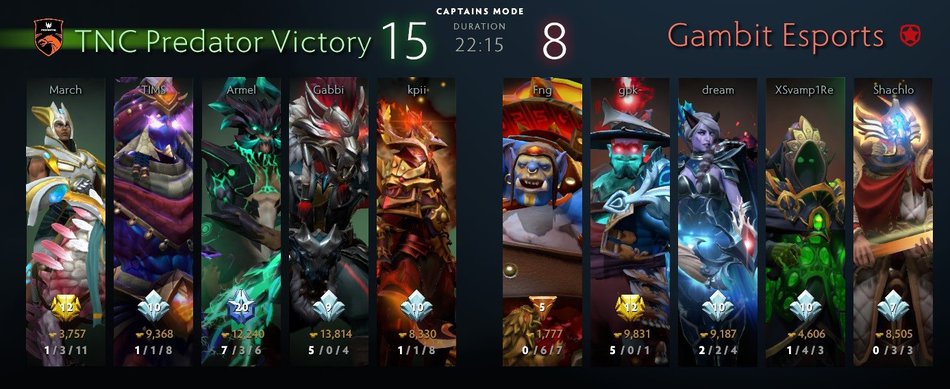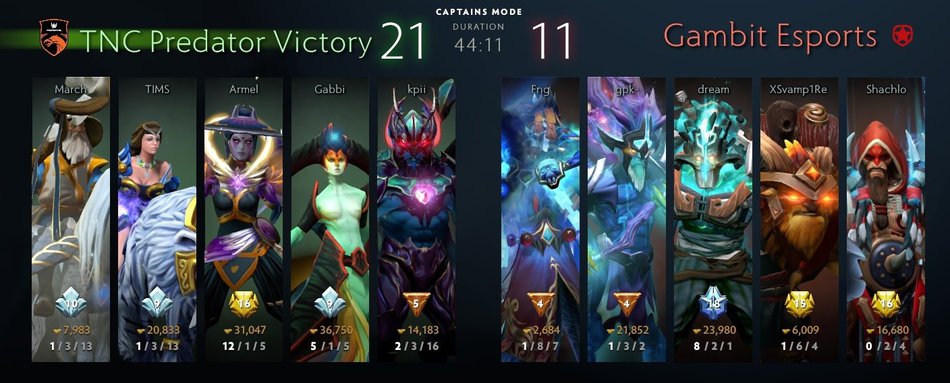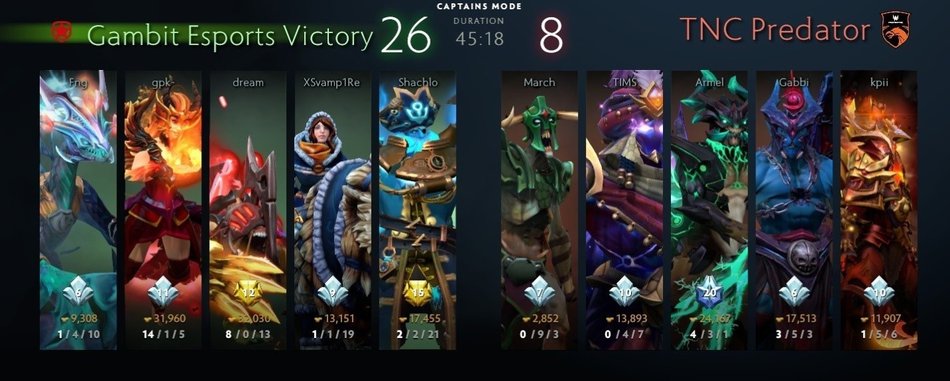- English
- Русский
In this article, we will review the ESL Hamburg Grand Final series between TNC Predator and Gambit Esports and try to extract a few valuable lessons from those entertaining matches.

(Dotabuff)
The first game was a really fast one, TNC Predator taking it with ease. The main reason for this is the picks in my opinion.
In the first game, TNC first picked Chen and then, in the later phases Enigma and Lycan. All of those heroes give enormous push ability and 5-man potential because of their units that are buffed by Lycan’s Howl. Even knowing this, the opponent team didn’t pick any wave clear or AoE damage hero that can deal with the units of TNC’s draft and instead opted for a Drow strat. None of Gambit’s heroes had effective wave clear and they were overwhelmed by their enemies when TNC just grouped up. TNC took objectives such as towers, Bounty runes, Roshan and Raxes without any problems.
It’s worth mentioning that Gambit had the last pick in the game and still opted for a Storm Spirit because of the Drow aura instead of a wave clearing hero.
Prioritizing your own strategy rather than fully adapting to the draft of your opponents is usually a good idea in most cases (e.g. in pubs you don’t want to draft heroes that you can’t play well-enough just because they theoretically counter your opponents). That said, if you fully ignore the strategy of the enemy team you might end up lacking any of the needed tools to deal with it and lose spectacularly.

(Dotabuff)
The second game was also a stomp (even though it lasted more than 40 minutes) - TNC Predator was only able to get 5 kills and were down by 31k+ networth by the end of the game.
In this game, TNC was completely out-drafted in my opinion. They picked 3 melee cores: Dragon Knight on the mid lane, Ogre offlane, and Slark in the safe lane. All of these heroes need some sort of farm to be useful and their supports can’t fight alone. On the other side, Gambit had Gyro, Ember, and Batrider as their cores, all heroes that can fight from the early game with their low cooldown spells.
Even though TNC had decent lane matchups, they couldn’t utilize the farm they got from the lanes since they understood that they couldn’t fight at all until they had Black King Bar on at least 2 cores. Because of this, they opted for triple Midas on cores, something that I wouldn’t recommend, but in this case, it was their only option. Their plan was to delay the game as long as possible until the late game when they would have a better chance of winning.
They weren’t able to do this without losing raxes and other objectives, however, even though they had Keeper of the Light and Lina to out-push the lanes. All in all, they just couldn’t afford to take a 5vs5 fight at all: this is clearly visible in the kill score and the damage dealt by their heroes. For example, their safe lane carry dealt 5k damage in a 40-minute game.
The simple truth is that team fight potential
wins games. It’s
theoretically possible (rat Dota), but in practice, it’s extremely hard to play
a successful game of Dota while entirely avoiding direct fights. If you draft a
team that is much weaker 5vs5 compared to the enemy team, you make the game
much harder than in needs to be.

(Dotabuff)
This game was pretty similar to the last one in the sense that one team had a far superior team fight in the early stages of the games - Gambit in this case.
TNC was forced to split-push and just play on the opposite side of the map in the early to midgame. However, they were better equipped to depush and push lanes with their spells such as Keeper of the Light’s Iluminate, Mirana’s Starfall, Templar Assassin’s Trap, and Naga’s Mirror Images. They were able to hold their towers or get something in return if one would fall in other parts of the map until their heroes came online.
Once their heroes hit their timings, however, TNC understood really well that the game plan can now change and that they can take fights. Their power spike was marked by an early Rosh kill because of TA, an early Pipe on Night Stalker, Mekansm on Mirana, and Diffusal Blade + Manta on Naga. With these core items, they were no longer in a team fight disadvantage and were able to successfully regain map control. They slowly started applying pressure and ultimately won the game.

(Dotabuff)
Game 4 is a great example of the impact the right support hero can have on the game. Usually in professional Dota the support + utility heroes are drafted first, and core heroes are drafted last to give your enemies little space in the draft to counter them. This usually means that in practice you are trying to counter the enemy cores with your last-pick cotes.
This doesn’t necessarily have to be the case, however. Some support heroes are perfectly capable of ruining the enemy team’s plans without needing farm and space of their own.
In this game, Gambit opted to first pick their offlane hero and let one support for the second phase of the draft. This turned out to be a really good choice since the enemies had an Enigma pick in the first draft, Legion Commander and Night Stalker in the later stages of the draft. Winter Wyvern was Gambit’s hero of choice, countering all of the heroes mentioned above in a different way.
WW is great against Legion since he provides a save in his Cold Embrace. His ultimate is amazing against Night Stalker in the sense that if NS uses his ultimate, WW can disable him while his team retreats. Last but not least, Winter’s Curse is great versus Enigma since it is a Black King Bar piercing spell, thus forcing Enigma to buy BKB AND Linken’s if he plans to use Black Hole in this game.

(Dotabuff)
This is the last game of the series so both teams put all the chips on the table. The game was pretty one-sided though, because of ThiS SImPLe TrICk:
This game is a great example of how devastating a cheese hero can be for the enemy team. In this case, TNC Predator decided to pick Alchemist and it turned out to be an amazing pick that ultimately won them the series.
The hero was picked since the enemy team had no hero to contest his farming, thus resulting in a 10-minute Radiance timing. The enemy team was formed of Ember Spirit, Life Stealer, Kunkka, Lich and Grimstroke. None of those heroes can take towers fast or enter the enemy jungle aggressively where Alchemist farms. Because of this, he was able to get really farmed, achieving 1.2k gold per minute over the course of the game.
His gold advantage translated into items and combined with a great draft that includes tanky healers such as Undying and Abaddon, they were able to get Rosh (with the help of additional armor reduction from Bristle), push hard using their gold advantage, and secure the victory.
A few days ago we wrote a “What we can learn” article about the Dreamleague S12 Grand Finals. With the two tournaments happening almost back-to-back in the same patch, it’s quite interesting to see if there were any big changes in the meta.
It’s quite obvious that the two tournaments happened close to each other on the same patch: the 4 most contested heroes were the same for both tournaments – Kunkka, Void, Gyro, Abaddon.
There are differences, however.
For example, Magnus was only picked and banned a total of 7 times in Dreamleague. In ESL, however, he was the 5th most contested hero with a total of 65 picks and bans in the main tournament.
Magnus is an interesting hero because he was historically played almost exclusively as a core (2nd and 3rd position), while in more recent times he’s finding great success as a pos. 4 hero.
The idea is that as a core Magnus is a bit unreliable. If he doesn’t get a good RP, his fight impact is low and it’s hard to justify all the resources invested in him. As a support, however, he just provides constant Empower to his cores and if he manages to cast a good RP in a fight that’s just a great bonus. The new Alliance team, for example, is a big believer in support Magnus and Handsken plays him often (his third most played hero in the last month).
This ability to run him in different positions makes Mag a more versatile pick than he used to be, and it’s quite logical that when there are melee carries in the meta, Mag will gradually start seeing more and more play on the competitive scene. Being more popular, however, doesn’t necessarily make him imba. He has a stable win rate of 52%, which is considerably lower than e.g. Abaddon, Mirana, and Shadow Demon, all of whom had above 60% WR in ESL One Hamburg and comparable success rate in Dreamleague.
In the last article, we talked about how it’s going to be important to judge how the currently absent T1 teams will perform once they return in the competitive scene (Secret, OG, etc.).
Another important event for pro Dota is also growing closer, however – the next big balance patch. As mentioned, the current meta is relatively stable and arguably well-balanced. When the new patch hits, however, it will take a while until teams figure out what strats and which heroes work best. When it happens, it will be very important to try to predict the over-performers in this time of turbulence both in terms of heroes/strats and in terms of teams that make good use of them.
Don’t forget that some players and teams naturally like playing some heroes more than others. If their favorite heroes are good performers in the new meta, the results of the said players/teams will certainly become better as well.
Thanks for reading! We hope you enjoyed the analysis and found it useful. If you did, make sure to check out IDQ's Dreamleague S12 Grand Finals article as well!